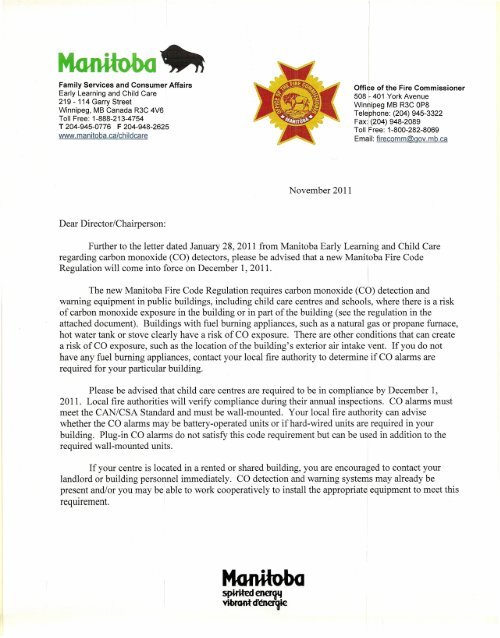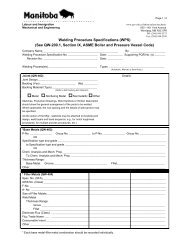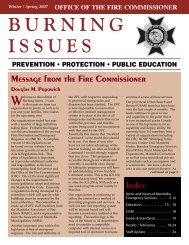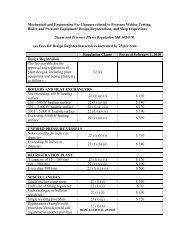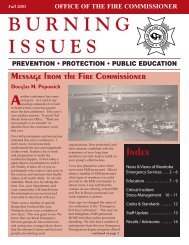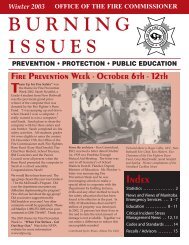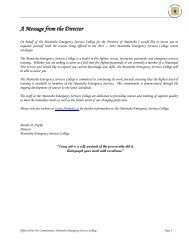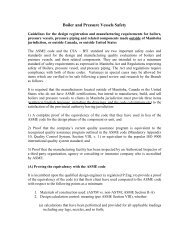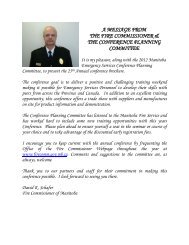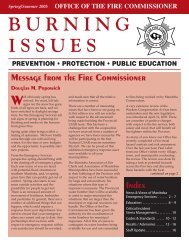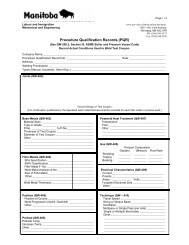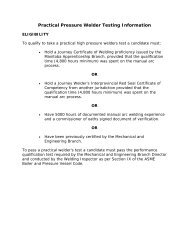Read "Letter to Director/Chairperson - Office of the Fire Commissioner
Read "Letter to Director/Chairperson - Office of the Fire Commissioner
Read "Letter to Director/Chairperson - Office of the Fire Commissioner
You also want an ePaper? Increase the reach of your titles
YUMPU automatically turns print PDFs into web optimized ePapers that Google loves.
Family Services and Consumer Affairs<br />
Early Learning and Child Care<br />
219 - 114 Garry Street<br />
Winnipeg, MS Canada R3C 4V6<br />
Toll Free: 1-888-213-4754<br />
T 204-945-0776 F 204-948-2625<br />
www.mani<strong>to</strong>ba.ca/childcare<br />
<strong>Office</strong> <strong>of</strong> <strong>the</strong> <strong>Fire</strong> <strong>Commissioner</strong><br />
508 ~401 York Avenue<br />
Win~ipeg MS R3C OP8<br />
Telephone: (204) 945-3322<br />
Fax:1(204) 948-2089<br />
Toll Free: 1-800-282-8069<br />
Email: firecomm@gov.mb.ca<br />
November 2011<br />
Dear Direc<strong>to</strong>r/<strong>Chairperson</strong>:<br />
Fur<strong>the</strong>r <strong>to</strong> <strong>the</strong> letter dated January 28, 2011 from Mani<strong>to</strong>ba Early Learning and Child Care<br />
regarding carbon monoxide (CO) detec<strong>to</strong>rs, please be advised that a new Mani<strong>to</strong>ba <strong>Fire</strong> Code<br />
Regulation will come in<strong>to</strong> force on December 1,2011.<br />
The new Mani<strong>to</strong>ba <strong>Fire</strong> Code Regulation requires carbon monoxide (CO) detection and<br />
warning equipment in public buildings, including child care centres and schools, where <strong>the</strong>re is a risk<br />
<strong>of</strong> carbon monoxide exposure in <strong>the</strong> building or in part <strong>of</strong> <strong>the</strong> building (see <strong>the</strong> regulation in <strong>the</strong><br />
attached document). Buildings with fuel burning appliances, such as a natural gas or propane furnace,<br />
hot water tank or s<strong>to</strong>ve clearly have a risk <strong>of</strong> CO exposure. There are o<strong>the</strong>r conditions that can create<br />
a risk <strong>of</strong> CO exposure, such as <strong>the</strong> location <strong>of</strong> <strong>the</strong> building's exterior air intake vent. If you do not<br />
have any fuel burning appliances, contact your local fire authority <strong>to</strong> determine if CO alarms are<br />
required for your particular building.<br />
Please be advised that child care centres are required <strong>to</strong> be in compliance by December 1,<br />
2011. Local fire authorities will verify compliance during <strong>the</strong>ir annual inspections. CO alarms must<br />
meet <strong>the</strong> CAN/CSA Standard and must be wall-mounted. Your local fire authority can advise<br />
whe<strong>the</strong>r <strong>the</strong> CO alarms may be battery-operated units or if hard-wired units are required in your<br />
building. Plug-in CO alarms do not satisfy this code requirement but can be used in addition <strong>to</strong> <strong>the</strong><br />
required wall-mounted units.<br />
If your centre is located in a rented or shared building, you are encouraged <strong>to</strong> contact your<br />
landlord or building personnel immediately. CO detection and warning systems may already be<br />
present and/or you may be able <strong>to</strong> work cooperatively <strong>to</strong> install <strong>the</strong> appropriate equipment <strong>to</strong> meet this<br />
requirement.
- 2 -<br />
In all cases, it is important <strong>to</strong> follow <strong>the</strong> manufacturer's instructions for installation. Please<br />
also be aware that each CO alarm unit has an expiry date noted on <strong>the</strong> packaging. The locations <strong>of</strong><br />
your CO alarms and <strong>the</strong> expiry dates should be documented in <strong>the</strong> Facility Overview <strong>of</strong> your<br />
enhanced safety plan <strong>to</strong> make sure <strong>the</strong> units are replaced as required. You must also follow <strong>the</strong><br />
manufacturer's instructions for testing, inspection and maintenance. These requirements should be<br />
documented in <strong>the</strong> Controlling <strong>Fire</strong> Hazards and Inspection and Maintenance <strong>of</strong> <strong>Fire</strong> Safety<br />
Equipment section <strong>of</strong> your enhanced safety plan.<br />
Please see <strong>the</strong> enclosed document: Safety Bulletin #1 CO Detec<strong>to</strong>r/Alarmsfor Homes and<br />
Small Buildings. For additional information, visit <strong>the</strong> web site for <strong>the</strong> Mani<strong>to</strong>ba <strong>Office</strong> <strong>of</strong> <strong>the</strong> <strong>Fire</strong><br />
<strong>Commissioner</strong> (www.firecomm.gov.mb.ca). If you have questions, you may contact <strong>the</strong> <strong>Office</strong> <strong>of</strong> <strong>the</strong><br />
<strong>Fire</strong> <strong>Commissioner</strong> at (204) 945-3322 or <strong>to</strong>ll free at 1-800-282-8069.<br />
A translated version <strong>of</strong> this letter will be sent <strong>to</strong> centres that request <strong>the</strong>ir correspondence<br />
French as soon as possible.<br />
I<br />
in<br />
Thank you for your cooperation in this matter and for your continued commitment <strong>to</strong> <strong>the</strong><br />
health, safety and well-being <strong>of</strong> children, families and staff at your centre.<br />
Sincerely,<br />
Sincerely,<br />
Margaret Femiuk<br />
Direc<strong>to</strong>r<br />
Mani<strong>to</strong>ba Early Learning and Child Care<br />
David Schafer<br />
Al<strong>Fire</strong> <strong>Commissioner</strong><br />
<strong>Office</strong> <strong>of</strong> <strong>the</strong> <strong>Fire</strong> <strong>Commissioner</strong><br />
Enclosures<br />
cc:<br />
Child Care Coordina<strong>to</strong>rs
CHANGES TO THE MANITOBA FIRE CODE EFFECTIVE DECEMBER 1, 2011<br />
2(5) The following is added after Article 2.1.3.8.:<br />
2.1.3.9. Carbon Monoxide Detec<strong>to</strong>rs<br />
1) Carbon monoxide detection and warning equipment shall be installed<br />
in a building or a part <strong>of</strong> a building that is required <strong>to</strong> be inspected<br />
under section 1 <strong>of</strong> <strong>the</strong> <strong>Fire</strong> Safety Inspections Regulation, Mani<strong>to</strong>ba<br />
Regulation 7312007, if a risk <strong>of</strong> carbon monoxide exposure eXist1 in<br />
<strong>the</strong> building or part <strong>of</strong> <strong>the</strong> building.<br />
2) Carbon monoxide detection and warning equipment that is required <strong>to</strong><br />
be installed under Sentence (1) shall be installed in conformance with<br />
NFP A 720-2009 "Standard for <strong>the</strong> Installation <strong>of</strong> Carbon Monoxide<br />
(CO) Detection and Warning Equipment."<br />
3) A carbon monoxide alarm that is required <strong>to</strong> be installed under this<br />
Article may be battery operated.<br />
4) All installations <strong>of</strong> carbon monoxide detection and warning equipment<br />
must be acceptable <strong>to</strong> <strong>the</strong> authority having jurisdiction.


